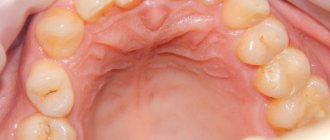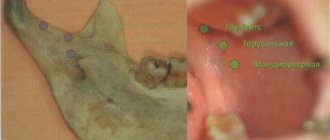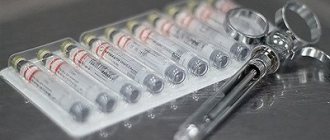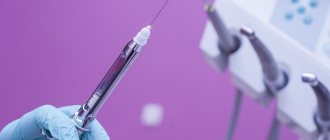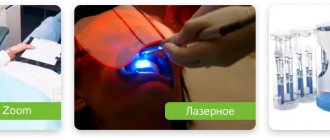Types of anesthesia in pediatric dentistry
Modern dental technologies are very diverse.
Hypnosis, musical sound analgesia, laughing gas, electroanesthesia, and infiltration anesthesia can be used as anesthesia for children during dental treatment. But more often they use methods based on proven medications and compounds. Protocols can be classified according to a variety of criteria. General gradation:
- local anesthesia;
- Oxygen sedation;
- deep sedation;
- general anesthesia.
There are also different methods of how dental anesthesia is given to children:
- topical anesthesia - smearing the gums with an anesthetic to locally “freeze” the nerve endings;
- injection anesthesia - administration of the drug using a carpule syringe with a particularly thin needle;
- mask for children - used in dentistry to administer anesthesia or a nitrogen mixture.
The names of drugs for pediatric anesthesia during dental treatment deserve special mention. Most often this is:
- Sevoran for general anesthesia is a highly effective inhalation anesthetic with the highest safety profile.
- Propofol for deep sedation is a completely safe composition for intravenous anesthesia.
The method of pain relief is selected taking into account the patient’s age, indications for use, and the amount of planned dental work.
Regional anesthesia in children and adolescents
Aizenberg V.L., Tsypin L.E., Lyannaya G.F. Russian State Medical University, Moscow
Regional anesthesia in pediatrics is a rapidly developing area of domestic anesthesiology. Only in the last four years it has firmly entered the arsenal of eight children's medical institutions in Moscow and is used in the form of combined or even independent anesthesia during operations on the abdominal organs, in pediatric oncology, urology, in orthopedics and traumatology, for minor surgical interventions and manipulations , so common in childhood.
All known types of regional anesthesia are used in children, but central blocks were the first to become most widespread: epidural, caudal, spinal and spinal epidural [3,5,6].
Since the beginning of the 70s of the last century, thanks to the work of domestic scientists, restrictions on peripheral blockades of plexuses and nerve trunks in children during operations on the limbs have been lifted [1,3].
And finally, with the advent of effective anesthetic creams such as EMLA, contact / surface anesthesia has become widespread in children for catheterization of veins, manipulation of the skin and when performing regional blockades. Moreover, you do not need to learn the last method of pain relief; you just need to follow the instructions included with the cream.
Rarely used methods today include intravenous regional anesthesia according to Beer, intraosseous and sheath anesthesia. Infiltration anesthesia is of auxiliary importance in children and adolescents.
A number of factors have contributed to the development of regional anesthesia in children.
First of all, this is the creation of an appropriate material and technical base: special needles, catheters, sets for various blockades in children, neurostimulators, local anesthetics of the amino-amide group, which raised the quality of regional blockades to a higher level and made it possible to perform them and use them with switching off the patient's consciousness due to the components of general anesthesia.
A certain role was played by the ideology of multicomponent anesthesia and the awareness that in a number of patients general anesthesia with artificial ventilation is not the method of choice and gives a number of extremely undesirable complications. This applies to the anesthesia of premature and infant children with pulmonary dysplasia, patients with a history of malignant hyperthermia, as well as children with neuromuscular diseases and some other categories of patients.
There are three undeniable advantages of regional anesthesia:
- Anesthesia, relaxation and autonomic blockade are limited only to the surgical area. Therefore, there is no need for artificial ventilation if the operation lasts more than one hour. Naturally, this does not apply to interventions on the chest organs and upper abdominal cavity. It is also important that with regional anesthesia in children, pharyngeal and laryngeal reflexes are preserved.
- Comfortable, painless and shortened postoperative period.
- Combined regional anesthesia is less expensive and directly or indirectly reduces the costs of surgery and the postoperative period.
In pediatric practice, regional anesthesia can be used in three options:
1. As an independent type of pain relief without turning off consciousness.
This is possible in newborns, infants and young patients with appropriate psychological preparation, adequate premedication that does not deprive the child of control, and complete anesthesia, both the regional blockade itself and the operation. Under similar conditions, surgical interventions can be performed in children and adolescents who are afraid of unconsciousness and loss of self-control during anesthesia. Or in well-cooperating older patients with a “full stomach” and requiring emergency surgery due to injury.
According to our data, about 18% of children and adolescents can be operated on without turning off consciousness during the operation.
The absolute indication for regional anesthesia is patients with a history of malignant hyperthermia.
2. As a component of general anesthesia with artificial ventilation through an endotracheal tube or laryngeal mask during surgical interventions on the chest, abdominal and pelvic organs.
As a rule, central types of blockades are used, including spinal - epidural anesthesia.
In this embodiment, regional anesthesia enhances the analgesic component and autonomic blockade in the surgical area, and subsequently provides analgesia in the postoperative period.
3. Regional anesthesia is performed in unconscious patients, and the unconscious state is maintained for the entire duration of the operation.
This is the most commonly used anesthesia option for children who, for various reasons, do not want or need to be present for surgery. In this case, epidural / caudal or blockade of plexuses and nerve trunks is more often used, and switching off consciousness is achieved with inhalational or intravenous anesthetics / hypnotics / in small doses. Combined regional anesthesia with switching off consciousness in a child is the method of choice for surgical interventions on the extremities and perineum. In our pediatric orthopedics and traumatology clinic, 25–30% of interventions are performed under this type of anesthesia.
Contraindications.
Absolute contraindications for regional anesthesia in pediatrics are:
- Infection in the blockade area.
- Repeated seizures.
- Coagulopathies that cannot be effectively corrected.
- Central regional blocks are contraindicated in children with anatomical abnormalities at the puncture site or neurological diseases that may progress.
- Severe hypovolemia or arterial hypotension, difficult to respond to emergency correction.
- Disagreement of patients or their parents.
Local anesthetics
Of the many well-known local anesthetics, three drugs are predominantly used in domestic practice in children: lidocaine, marcaine and naropin. Ultracaine is used to a limited extent.
Lidocaine is usually used as a 1% solution. For peripheral blockades, adrenaline is added to it at a rate of 5 mcg/ml. The drug is characterized by a short latency period of 10–12 minutes and an average anesthesia time of 2–2.5 hours in children. Lidocaine provides postoperative analgesia for about 4–7 hours without additional administration. Its total dose for peripheral blockades is 7–9 mg/kg body weight.
Marcaine /bupivacaine/ - has a longer latency period of up to 20 minutes, but provides long-term anesthesia of up to 7 hours; postoperative analgesia when using Marcaine can last up to 20 hours or more. Its disadvantage should be considered neuro and cardiotoxicity, which occur with an overdose or accidental introduction of marcaine into the bloodstream. The total dose of marcaine for central and peripheral blockades in children is 2 – 2.5 mg/kg of the child’s body weight. By manipulating the dose of the drug, a differentiated block can be caused. It is used in children in the form of a 0.25% or 0.5% solution.
Naropin (ropivacaine) is a drug in many ways similar to marcaine, but produces a shorter motor block and is less cardiotoxic. Therefore, it can be used for regional intravenous anesthesia according to Beer. In pediatric practice, 0.25% - 0.375% and 0.5% solutions are used in a dose of 2 - 2.5 mg/kg body weight.
Comparative characteristics of the drugs according to our clinic are given in Table 1.
Table 1 shows that with a similar duration of anesthesia, the latent period of naropin is shorter than that of marcaine. Together with low cardio and neurotoxicity, this makes naropin more attractive in pediatric practice compared to marcaine.
It must be noted that the main problem with the use of these local anesthetics is the fact that the pharmacopoeia and other documents regulating the use of pharmacological agents in our country do not have clearly defined recommendations regarding their use in childhood. Anesthesiologists in most countries do not encounter such difficulties.
Premedication
Patients undergoing surgery under regional combined anesthesia require premedication. The exception is children under 6 months.
But premedication should not cause deep sedation and deprive the anesthesiologist of contact with the child. It is not necessary to include atropine in the preoperative preparation unless there are special indications, for example, during artificial ventilation of the lungs using muscle relaxants, or high concentrations of fluorotane.
Atropine can be used as premedication in infants, due to the relative weakness of their sympathetic system and the dominance of the parasympathetic, but it can be avoided in school-age children and adolescents.
In most children, it is possible to do without the inclusion of narcotic analgesics in premedication, since analgesia is not needed to perform a regional block, and during surgery the problem of analgesia is reliably solved by regional anesthesia itself. This is especially relevant in social terms due to the increase in drug addiction. Excluding promedol from premedication reduces the frequency of vomiting when consciousness is turned off with inhalational anesthetics. The most commonly used analgesic for premedication in children with regional anesthesia is paracetamol, its single dose is 15–25 mg/kg body weight. The most convenient forms of paracetamol are in syrup or suppositories. It is good to combine it with midazolam endonasally in drops or orally at a dose of 0.25 - 0.4 mg/kg. Sleep comes in about 10 minutes. But the child can be woken up and contacted, since the sedative effect of midazolam wears off after 30 minutes. The combination of ketamine (2 mg/kg) and midazolam (0.4 mg/kg) provides the most effective sedation in unruly and agitated patients. For regional anesthesia, it is logical to perform sedation using short-acting barbiturates at a dose of 2–4 mg/kg body weight. In children 2–3 years old, it is better to use the rectal route, and older patients can take barbiturates by mouth 1–1.5 hours before surgery.
This premedication has an anticonvulsant effect and may be useful in mild overdoses of local anesthetics.
In addition to the above-mentioned drugs, the following are used: instead of midazolam - Relanium or diazepam, instead of paracetamol - drugs from the group of non-steroidal anti-inflammatory drugs that have a good analgesic effect, /nurofen, nimulide, ketorolac, etc./ in age-related dosages.
Turning off consciousness
In most pediatric and adolescent patients, switching off consciousness during regional anesthesia and during surgery is necessary. According to our data, more than 70% of children undergoing surgery need this.
For this purpose, both inhalational and intravenous anesthetics are used, as well as hypnotic drugs such as propofol.
Inhalational anesthetics, such as nitrous oxide with oxygen (1:1) and fluorothane at a dose of 0.4–0.6 vol/%, are more manageable and are used most often, especially at the beginning, when the child needs to establish venous access before surgery, yes and the injection of propofol into a vein is accompanied by painful sensations.
Nitrous oxide remains one of the most attractive and most popular inhalational anesthetics in children in the world today. Inhalational anesthetics allow, if necessary, to quickly deepen general anesthesia and quickly return to its initially low level. The use of ftorotan in minimal doses to turn off consciousness during regional anesthesia is not advisable in children with increased intracranial pressure, but the addition of adrenaline to local anesthetics at a dose of 5 mcg/ml against the background of ftorotane is not contraindicated.
The use of a local anesthetic cream such as EMLA allows school-age children to use an intravenous method of turning off consciousness using a small “butterfly” needle installed in a peripheral vein in the arm. Typically, sodium thiopental is used at a dose of 5-6 mg/kg or ketamine (1-2 mg/kg). Propofol (2-3 mg/kg) has been widely used in recent years. Painful sensations along the vein from its introduction are leveled by a mixture of propofol with a solution of lidocaine.
Central blockades
In childhood, any central blockade is used. This is possible from the neonatal period. Children have a number of advantages over adult patients that you need to be aware of.
They rarely have chronic diseases of the cardiovascular system, heart rhythm disturbances, arterial hypertension, and the tendency to hypotension under the influence of central blockades does not appear until a certain age.
Thus, spinal anesthesia in children under 5 years of age is not accompanied by noticeable arterial hypotension, epidural anesthesia does not reduce blood pressure in children under 8 years of age, and caudal anesthesia does not affect hemodynamics at all. Therefore, in these categories of patients there is no need to carry out preliminary “venous support” or resort to the use of sympathotonic agents.
In young children, the turnover of cerebrospinal fluid is accelerated compared to adults, so even the use of marcaine for spinal anesthesia provides them with pain relief for up to 1.5 - 2 hours, and this is not enough for serious and lengthy operations. Therefore, it is in children that it is necessary to develop combined spinal - epidural anesthesia, which is the method of choice for abdominal operations in children.
There are three methods of spinal-epidural anesthesia: single-level, two-level and using the Epistar needle, which allows you to insert an epidural catheter, administer an epidural test - a dose of anesthetic, and then perform spinal anesthesia through another channel of the same needle. This sequence of manipulations eliminates trauma to the subarachnoid space with the epidural catheter.
During central blocks, the level of location of the spinal cord and dura mater depending on age should also be taken into account.
By the time the fetus is born, its spinal cord ends at level L 3, and the dura mater in newborns ends at level S 4. By the age of one year, due to growth disproportions, the level of the spinal cord rises to L 1, the dura mater ends at S 2-3. The line connecting the iliac crests crosses the midline in infants at the level of the fifth lumbar vertebra, and in a newborn even lower - at the level of L 5 - S 1. Thus, a puncture performed higher than L 4 in infants is fraught with danger spinal cord needle injury.
It should also be noted that in newborns and infants the epidural space contains much less adipose tissue and vessels than in older patients and adults, therefore, in the neonatal period and infancy, it is possible to pass the epidural catheter from the caudal access to any desired level for epidural anesthesia subject to subsequent verification of its location.
Thus, the characteristics of childhood are more likely to favor the use of central blocks with combined anesthesia for surgical interventions in children than to impose restrictions on their use.
Peripheral blockades of plexuses and nerve trunks.
Restrictions on peripheral blockades of plexuses and nerve trunks in children were lifted in the early 70s after the advent and widespread implementation in different countries of the method of neurostimulation for a painless search for mixed and motor nerve trunks, the achievement of which was judged by the response of the corresponding muscle group [1,3] .
Then it seemed to us that with the use of neurostimulators at any age, failures in performing peripheral blockades would go away. Today, dozens of types of neurostimulators have been created, but a certain, small percentage of incomplete anesthesia is still observed and, according to various authors, amounts to 3–7%. This may be due to an insufficient volume of anesthetic, or a concentration lower than that required for this operation, as well as to anatomical variants of the nerve trunks that cannot be known in advance.
The search for nerve trunks occurs first at a current strength of 1–2 mA with a frequency of 2 hertz. This allows you to approach the nerve at a distance of approximately 1 cm. The needle and nerve come together at a current strength of 0.3 - 0.4 mA, the distance decreases to 2 mm, but the needle approaches the nerve from one side and the bevel of the needle can be directed away from the nerve trunk. In cases where the anesthetic solution tightly fills the fascial sheath containing nerve trunks and vessels, anesthesia is usually sufficient. An example is an axillary block of the brachial plexus during operations on the hand or lower third of the forearm. But when the nerve plexus is located in the form of a “crow's foot”, or branches that innervate the operation area extend from it above the level of anesthesia, then failures are possible. This applies to the lumbar plexus and all parts of the brachial plexus except the axillary fossa. In these cases, it is necessary to inject an anesthetic along the expected front of the plexus location or identify each nerve trunk separately by characteristic movements of the hand or forearm and anesthetize it. This is what we do when anesthetizing the brachial plexus using an infraclavicular approach in our own modification, anesthetizing two or three nerve trunks in turn. The method provides anesthesia up to the middle of the shoulder in the absence of complications [5].
Blockade of the sciatic nerve, the largest nerve in humans, requires a sufficiently high concentration of anesthetic in accordance with the age of the child and regardless of the approach, with the needle as close as possible to the nerve trunk.
In the literature of the last two years, reports have appeared on the identification of nerve trunks for regional anesthesia using ultrasound diagnostics with high-frequency sensors, including in childhood. Similar studies have begun in our country.
Complications.
Complications when performing peripheral regional anesthesia in children with modern equipment are extremely rare. Thus, in our orthopedic-surgical clinic over the past 4 years, there have been three unintentional punctures of a vessel per 1,500 anesthesias, which is 0.2%.
With central blockades, complications are observed more often and can be divided into two groups: specific and nonspecific.
A group of specific complications is usually associated with technical errors or specific properties of individual anesthetics and technical means. They are usually observed during the period of mastering the techniques
Much more serious are nonspecific complications, among which it is necessary to highlight toxic reactions associated with an overdose of an anesthetic or accidental direct injection into the vascular bed, aseptic and infectious inflammation in the form of meningitis, epiduritis, aseptic arachnoiditis and, of course, total block during spinal anesthesia. The total number of such complications, according to various authors, does not exceed 0.16-0.4%, and they may not have serious consequences if the anesthesiologist is prepared to eliminate them [2,4].
In conclusion, it must be emphasized that the main task of today is the need to widely introduce effective, fairly safe and economical methods of regional anesthesia into the practice of anesthesiologists working with children, at least to the same level as in the surgical treatment of adults.
Literature.
- Eisenberg V.L. // Vestn. surgery.-1972.-No. 5 – pp. 88 – 92.
- Aizenberg V.L., Pogodaeva E.N. // Clinical surgery. – 1975. – No. 5. pp.43 – 44.
- Aizenberg V.L., Tsypin L.E. Regional anesthesia in children. – M. Olympus. – 2001.- 240 p.
- Steor R.Ya., Blazhenov M.B., Aizenberg V.L. // Journal of Intensive Care. – 1998. – No. 1. – pp. 27 – 29.
- Aizenberg V.L., Tsypin L.E., Lyannaya G.F. // Anesthesiology and resuscitation. – 2003. – No. 1. – p.56 – 59.
- Dalens BJ Pediatric regional anesthesia. CKC Press Radio. Florida, - 1990.- p.491.
Regional anesthesia and pain management. Thematic collection. Moscow-Tver 2004, pp.211-221
Local anesthesia in dentistry for children
Local anesthesia is an anesthesia that temporarily blocks the transmission of nerve impulses. This means that during the treatment the child does not feel pain or discomfort. Dentists use local anesthetics as medications, selecting the composition after determining the patient’s allergic reactions.
Local anesthesia for children's teeth is usually carried out in two stages:
- application - for primary reduction of sensitivity;
- injection - administration of an anesthetic composition through an injection of an anesthetic.
Anesthesia for the treatment of baby teeth in very young patients takes place in three stages. The first is application “freezing”. The second and third are injection anesthesia. The first injection of anesthetic is performed with a minimum dose, a drop. Anesthesia takes effect almost immediately, after which the entire volume of the drug is administered.
Rodikova Tatyana
With children 3-4 years old we usually play a fairy tale - based on Frozen or invent our own. First, we smear the gums with “magic ice jam”, then we cast a spell like Elsa “to freeze microbes.” And after that we “make Olaf the snowman” or simply “freeze everything around.” Kids are happy to listen and help, which eliminates tears and whims during dental treatment.
Local anesthesia in children in dentistry
Local anesthesia is the most popular method of pain relief in children and adults. In turn, it is divided into application and injection (conductive and infiltration).
Topical anesthesia for children in dentistry
Topical anesthesia is often used in pediatric dentistry because it does not require injections. The essence of the technique is to apply an anesthetic drug to the gums and/or mucous membranes in the form of a gel, solution or spray. The active substance is absorbed through the top layer and significantly reduces tissue sensitivity. The whole process takes no more than 5–10 minutes. Pain relievers have a pleasant aroma and taste, which is why the process of applying them does not cause negativity in the child.
The effectiveness of such anesthesia is low, since the anesthetic drug is unable to penetrate deeply, but it is quite enough to perform simple manipulations: injecting an anesthetic or removing already loose baby teeth.
Injection anesthesia in pediatric dentistry
The essence of injection anesthesia is the introduction of an anesthetic drug into the tissue. The amount of the product and the point of its administration depend on the upcoming manipulation. To relieve pain during dental procedures in children, conduction and infiltration anesthesia are used.
The essence of conduction anesthesia is the injection of the drug into the area where a large nerve trunk passes. Under the influence of the drug, the passage of impulses through it stops, which allows you to “turn off” sensitivity in half of the jaw. In this way, a high degree of pain relief is achieved, making it possible to carry out manipulations of any complexity.
Infiltration anesthesia is very often used in pediatric dentistry. It is based on the impregnation (infiltration) of tissues with an anesthetic solution, as a result of which they lose their sensitivity. The process requires layer-by-layer administration of the drug, provides high-quality local “freezing” and allows the use of additional doses of the drug if necessary.
Modern dental clinics use not only classic syringes, but also modern types of injectors to administer anesthetic, which significantly reduce discomfort during the process:
- needleless injector: the drug is delivered in a very thin jet under pressure, which allows it to “pierce” the tissue and penetrate into its thickness; Moreover, the size of the hole is significantly smaller than after a classic injection;
- capsule syringes: pre-equipped with a capsule with an anesthetic drug, which allows for a higher degree of sterility and a more precise dosage calculation; The products are equipped with special thin needles;
- computer syringes: the solution supply is electronically controlled for precise dosing.
Regardless of the chosen method, most pediatric dentists prefer to combine injection anesthesia with application anesthesia. Pre-treatment of the gums with an anesthetic makes it possible to painlessly introduce the drug into the tissue.
Oxygen-nitrogen sedation
ZAX is a mixture of oxygen and nitrous oxide, often known as laughing gas. Served through a mask. After inhaling the gas, the child falls into a relaxed, sleepy state, calmly perceives the surrounding reality, hears and understands speech addressed to him.
- maintains a positive mood - at the same time as treatment, the child watches cartoons and gets great pleasure from it;
- neutralizes pain - the pain threshold increases, which allows you to endure dental treatment comfortably and calmly;
- reduces natural reactions - the child is no longer frightened by bright lamps and the buzzing of the drill.
Superficial ZAX sedation is recommended for patients over three years of age and, with an experienced doctor, can replace pediatric anesthesia during dental treatment.
Deep sedation with Propofol - drug-induced sleep
During dental treatment, anesthesia for children or deep sedation may be used. These concepts are often confused, since in both cases the child is immersed in medicated sleep. But the difference is significant:
- General anesthesia in dentistry is given to children through a mask. Artificial sleep is as deep as possible, with complete loss of sensitivity.
- Sedation with Propofol involves intravenous administration of the drug and requires additional pain relief.
Propofol guarantees:
- natural physiological state of sleep;
- falling asleep in 1-2 minutes;
- exceptionally high safety for the child;
- simple awakening and rested state;
- extremely low risk of allergic reactions and side effects.
The quality and depth of sleep is controlled by an anesthesiologist. At this time, dentists treat and save teeth, remove completely destroyed units, and install prosthetic structures.
Local anesthesia
This method involves local anesthesia. In this case, the child is conscious and can communicate with the doctor and parents if they are present in the office. In dentistry for children
Most often,
topical anesthesia
- superficial application of an anesthetic to the gums in the form of a spray or gel. This anesthesia is always used immediately before the injection (injection) into the gum. It allows you to numb the injection site and the injection of the anesthetic drug itself is painless.
If strong anesthesia is required for one or more teeth, infiltration
(numbes the mucous membrane in the area of one tooth) or
conduction anesthesia
(numbs the area in the area of several teeth) - injection of the drug into the space next to the nerve innervating the operated area. To avoid pain from the injection, this method is usually combined with the application method.
Benefits of local anesthesia:
- high safety for children;
- accessibility and ease of use;
- low price;
- local anesthesia in pediatric dentistry allows you to remove the dental nerve in one visit;
- no effect on general well-being;
- high efficiency when used correctly;
- minimum consequences and side effects
Local anesthesia in children in dentistry
is used most often because it is the fastest, simplest and most convenient method of pain relief that does not require lengthy preparations (if it is known for sure that the child is not allergic to the drug).
Deep sedation with Propofol - drug-induced sleep
Dental anesthesia for children
Dental treatment for young children under anesthesia raises the maximum number of questions among adults. The main ones relate to the safety of the procedure and side effects. Parents are also interested in what kind of anesthesia they give their children during dental treatment - whether there are high risks of negative consequences.
Is anesthesia harmful for dental treatment for children?
Sevoran is a non-narcotic, non-toxic, completely safe drug that is used in dentistry for treatment under general anesthesia. It is given to the child through a mask, instantly putting him to sleep.
Among the advantages of the drug, confirming its safety for young patients:
- excreted from the body unchanged;
- does not affect internal organs;
- does not depress the heart;
- maintains physiological blood pressure readings.
Sevoran simply turns off consciousness and does not cause side effects. Additional positive points:
- pain relief - doctors do not administer additional drugs to the child;
- pleasant smell - children themselves breathe through the mask with pleasure;
- quick recovery from anesthesia - awakening takes only 10-15 minutes.
The high quality of the composition ensures that the use of anesthesia for dental treatment for children eliminates any unpleasant consequences.
Anesthesia at the dentist for children: features
Having figured out whether it is possible to treat a child’s teeth under general anesthesia, parents begin to prepare the child for the procedure.
To do this, the young patient is prescribed a series of examinations:
- Consultation with a dentist.
The doctor must assess the amount of work - determine caries, pulpitis, and the intensity of tooth destruction. Together with the parents, a decision will be made on how many teeth to treat, what to remove, and whether prosthetics are necessary. - Testing, primary diagnostics.
The basic set of studies is general and biochemical blood tests, electrocardiogram (ECG).
- Obtaining permission from a pediatrician.
If there are chronic diagnoses, the child is also sent for a consultation with a specialized specialist in order to eliminate any risks during dental treatment.
When all issues are agreed upon, the doctor sets a date for treatment and gives final recommendations.
Soldatenkova Alina
When removing baby teeth, it is very important to preserve space for future permanent ones. To do this, they either undergo prosthetics or go to an appointment with an orthodontist to install an orthodontic seat holder.
Pediatric anesthesiology is a separate branch of anesthesiological science. Approaches to anesthesia for children are generally similar to those for adult patients, but at the same time, there are very significant differences in certain issues. Considering that specialization in anesthesiology implies the ability of a doctor to provide anesthesia to a patient of any age, we believe that this article may be useful for doctors who mainly work with adult patients, but periodically encounter children in their practice.
Anatomical and physiological features strongly depend on the age of the child, and the older the child, the fewer these features become. A special group consists of newborns and children under one year of age, since this category of patients has many nuances. It should be understood that a child is not an adult of miniature size and weight, so you cannot limit yourself to just adjusting the doses of drugs used for pain relief. Each age of the child has its own specific characteristics, detailed information about which is available in the pediatric literature.
A preoperative examination of a child must necessarily include a medical history, including information about heredity and possible congenital pathology, as well as a history of the child’s growth and development. It is necessary to discuss in detail with the parents the choice of anesthesia, explain all the features, inform about possible complications and obtain written consent for anesthesia. If necessary, additional examination and consultation with specialists are prescribed. Assess the condition of the respiratory tract. The peripheral venous network is assessed for the possibility of catheterization of peripheral veins. Planned operations are postponed if the child has recently suffered a respiratory viral infection, has an exacerbation of chronic respiratory pathology or other pathology. It is necessary to give parents clear recommendations regarding the period of fasting before anesthesia, in accordance with the age of the child.
Necessary monitoring during anesthesia in children includes non-invasive blood pressure measurement, pulse oximetry, EC monitoring, gas monitoring, and body temperature monitoring. If necessary, this can be supplemented with advanced hemodynamic and other monitoring.
For anesthesia in children, general anesthesia, regional anesthesia, and a combination of these can be used. It is necessary to understand that a child under the age of 15 inclusive should not be present at his own operation, therefore the use of regional techniques is combined with general anesthesia or deep sedation. Regional anesthesia in children includes spinal, epidural, caudal, and conduction anesthesia. When performing peripheral regional blockades, ultrasound navigation and a neurostimulator should be used, which can significantly reduce the required amount of local anesthetic, speed up the blockade, make it less traumatic and reduce the number of complications. All peripheral regional blocks in children should be performed under deep sedation or general anesthesia.
General anesthesia in children usually includes mask and laryngeal-mask anesthesia, as well as general endotracheal anesthesia. In planned pediatric anesthesiology for short-term interventions, mask anesthesia with inhalation anesthetics (sevoflurane) is widely used while maintaining spontaneous breathing. Laryngeal mask anesthesia is performed for longer operations. For long-term interventions requiring the use of muscle relaxation, general endotracheal anesthesia with tracheal intubation and artificial ventilation is used. When performing emergency operations on children, given the danger of a full stomach and aspiration complications, general endotracheal anesthesia is also used.
In some situations, general intravenous anesthesia may be used in children, when intravenous anesthetics are administered through venous access directly into the bloodstream, while monitoring the patency of the upper respiratory tract and respiratory support is mandatory.
After the operation, the child awakens on the operating table, or, if necessary, is transferred to the intensive care unit for prolonged artificial ventilation in the postoperative period. If the child awakens on the table and does not require transfer to the intensive care unit, then after completion of anesthesia he is transferred to the recovery room, where he remains until recovery from anesthesia under the supervision of an anesthesiologist and nurse anesthetist.



